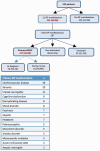Evolving phenotype of systemic lupus erythematosus in Caucasians: low incidence of lupus nephritis, high burden of neuropsychiatric disease and increased rates of late-onset lupus in the 'Attikon' cohort
- PMID: 32106788
- PMCID: PMC7168806
- DOI: 10.1177/0961203320908932
Evolving phenotype of systemic lupus erythematosus in Caucasians: low incidence of lupus nephritis, high burden of neuropsychiatric disease and increased rates of late-onset lupus in the 'Attikon' cohort
Abstract
Objective: This study aimed to analyse the phenotype of systemic lupus erythematosus (SLE) at first presentation and during follow-up in a newly established SLE cohort based at 'Attikon' University Hospital. The hospital combines primary, secondary and tertiary care for the region of Western Attica, Greece.
Methods: This study comprised a mixed prevalent and incident cohort of 555 Caucasian patients diagnosed with SLE according to American College of Rheumatology 1997 criteria and/or the Systemic Lupus Erythematosus International Collaborating Clinics (SLICC) 2012 criteria. Demographic and clinical characteristics, patterns of severity, treatments and SLICC damage index were recorded for each patient at the time of diagnosis and at last evaluation.
Results: The mean age at lupus diagnosis was 38.3 years (standard deviation = 15.6 years), with a median disease duration at last follow-up of two years (interquartile range 1-11). At initial presentation, the most common 'classification' manifestations were arthritis (73.3%), acute cutaneous lupus (65%) and unexplained fever (25%), while among symptoms not included in any criteria set, Raynaud's phenomenon (33%) was the most common. Kidney and neuropsychiatric involvement as presenting manifestations were present in 10.3% and 11.5% cases, respectively. Irreversible damage accrual was present in 17.8% within six months of disease diagnosis, attributed mainly to thrombotic and neuropsychiatric disease. At last evaluation, 202 (36.4%) patients had developed severe disease, of whom more than half were treated with pulse cyclophosphamide.
Conclusion: In this cohort of Caucasian patients, lupus nephritis is not as common as in older cohorts, while neuropsychiatric disease is emerging as a major frontier in lupus prevention and care. These data may help to document changes in the natural history and treatment of SLE over time and may have implications for its early recognition and management.
Keywords: Prevalent cohort; damage; incident cohort; lupus criteria; non-lupus criteria.
Figures



References
-
- Gergianaki I, Fanouriakis A, Repa A, et al. Epidemiology and burden of systemic lupus erythematosus in a Southern European population: data from the community-based lupus registry of Crete, Greece. Ann Rheum Dis 2017; 76: 1992–2000. - PubMed
-
- El Hadidi KT, Medhat BM, Abdel Baki NM, et al. Characteristics of systemic lupus erythematosus in a sample of the Egyptian population: a retrospective cohort of 1109 patients from a single center. Lupus 2018; 27: 1030–1038. - PubMed
-
- Mosca M, Costenbader KH, Johnson SR, et al. Brief report: how do patients with newly diagnosed systemic lupus erythematosus present? A multicenter cohort of early systemic lupus erythematosus to inform the development of new classification criteria. Arthritis Rheumatol 2019; 71: 91–98. - PubMed
-
- Li D, Yoshida K, Feldman CH, et al. Initial disease severity, cardiovascular events and all-cause mortality among patients with systemic lupus erythematosus. Rheumatology (Oxford). Epub ahead of print 3 September 2019. DOI: 10.1093/rheumatology/kez433.
-
- Bertsias GK, Pamfil C, Fanouriakis A, Boumpas DT. Diagnostic criteria for systemic lupus erythematosus: has the time come? Nat Rev Rheumatol 2013; 9: 687–694. - PubMed
MeSH terms
LinkOut - more resources
Full Text Sources
Medical

